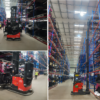Summary: The Alliance has released 16 group standards.
 Samsung recently in industry, and promote high-quality development of the industry, in accordance with the work instructions of the Mobile Robot Industry Alliance Standardization Technical Committee (referred to as the “Standardization Committee”), and after review by organized experts, the establishment of two alliance groups was approved in 2024. The standards and standard names are respectively drafted as “Modular Design Specifications for Mobile Robots for Industrial Applications” and “Technical
Samsung recently in industry, and promote high-quality development of the industry, in accordance with the work instructions of the Mobile Robot Industry Alliance Standardization Technical Committee (referred to as the “Standardization Committee”), and after review by organized experts, the establishment of two alliance groups was approved in 2024. The standards and standard names are respectively drafted as “Modular Design Specifications for Mobile Robots for Industrial Applications” and “Technical
Requirements for Explosion-Proof Fork-Type Mobile Robots”.
At this stage, the depth and breadth of mobile robot applications are constantly expanding, which means that higher requirements will be placed on the stability, safety, and compliance of mobile robots. In order to promote the development of the mobile robot industry, the CMR Industry Alliance has also been We are actively formulating relevant group standards and constantly improving the construction of China’s mobile robot standard system. Up to now, under the organization of the Alliance Standards Committee, the Alliance has released 16 group standards, covering basic categories, specification categories, testing categories, product categories, method categories, device supporting categories, etc.

Samsung announces cancellation of autonomous driving research and development, turning to humanoid robots
Summary: Mobile phone manufacturers will compete in the “humanoid robot” market again
Recently, after Apple announced the cancellation of its self-driving electric vehicle manufacturing plan (“Project Titan”), South Korean mobile phone giant Samsung also announced the cancellation of self-driving research and development.
New Strategy for Low-Speed Autonomous Driving All Media Overseas learned that just last week, SAIT (formerly Samsung Advanced Institute of Technology), which is responsible for advanced research of Samsung Electronics’ Semiconductor Division (DS Division), made the decision to suspend research on autonomous vehicles. SAIT will also transition developers working on self-driving software into “robotic intelligence” research and conduct research into future robotics, including humanoid robots.






